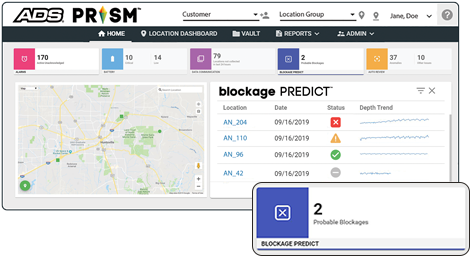Trusted Solutions for
Blockage Prediction and Overflow Prevention
ADS blockage PREDICT and Overflow Mitigation can help...
Sanitary Sewer Overflows (SSO)
...occur when raw sewage is released into waters, causing water quality problems, back up into homes, damage to private/public property, threatening public health and safety, all while adding to already strained resource allocation.
Wastewater collection systems fall into one of two types: Combined or Sanitary. Unlike Combined Sewers, which are designed to collect large volumes of storm waters in addition to sewage and industrial wastewater, Sanitary Sewers are built to collect and transport only domestic, commercial and industrial wastewater for appropriate treatment. While there are similarities, there are unique approaches that have to be made to both types.
ADS provides a comprehensive solution for predicting blockages,
optimizing sewer cleaning, and preventing overflows.
This enables network operators with the ability to clearly understand the current hydraulics of the sewer system, allowing teams to respond in real time to identify and clear blockages regardless of the weather conditions, alert residents to potential flooding as well as construct models over time to improve network performance. ADS real-time monitoring provides continuous feedback at remote collection system sites; providing actionable insight on exactly when and where sewer cleaning is needed, eliminating exaggerated cleaning practices and reducing frequency. Ongoing, continuous sewer monitoring provides enhanced assurance against SSOs.

ADS has developed blockage PREDICT™ to detect the earliest signs of blockages – allowing sewer cleaning resources to be deployed at the right place at the right time in a proactive manner.

How does blockage PREDICT work? An ADS ECHO level monitor is installed upstream from a location of interest, measuring sewer flow depth at regular time intervals. This data is transmitted periodically to the Cloud where a machine learning (ML) algorithm evaluates the data – looking for tell-tale signs of developing blockages. The results are available in the PRISM™ web app in an intuitive, easy-to-use format. Blockage PREDICT predicts developing blockages with enough notice to plan a proactive response with the right resources at the right time to prevent an overflow before it occurs.

For SSO mitigation, the ECHO uniquely provides 20 feet of visibility below the unit and up to eight feet above it. The ECHO always knows the water level in a manhole and provides multiple configurable alarms for advanced warning. The ECHO monitors bypass sites providing 24/7 protection against SSOs.
For efficient sewer cleaning, the ECHO enables utilities to employ the latest cleaning practices. Continuous remote monitoring with advanced visibility assures that cleaning is performed only when needed.
>> Contact us to discuss your application or request a Demo.
